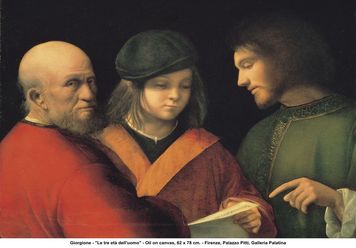The press release’s headline read “The Most Enigmatic and Mysterious Artist of the Renaissance,” and I was intrigued. The question (“who’s that?”) had never occurred to me. But I do like art-history mysteries (more are here, here, here, here and here), so I read on.
 The artist turned out to be Giorgione (b. circa 1477-78), and he’s a bit of a mystery because — the exhibition description says — “the documents that outline his biography can be counted on one hand and are all limited to the final stage of his life, which the plague brought to a premature end in 1510. Giorgione isn’t even mentioned by name in the 16th century, but is always referred to via his place of origin as the painter ‘from Castelfranco’ or – as in a 1528 inventory – as ‘Zorzon,’ a nickname that according to Vasari derives ‘from the build of the man and his greatness of soul’.”
The artist turned out to be Giorgione (b. circa 1477-78), and he’s a bit of a mystery because — the exhibition description says — “the documents that outline his biography can be counted on one hand and are all limited to the final stage of his life, which the plague brought to a premature end in 1510. Giorgione isn’t even mentioned by name in the 16th century, but is always referred to via his place of origin as the painter ‘from Castelfranco’ or – as in a 1528 inventory – as ‘Zorzon,’ a nickname that according to Vasari derives ‘from the build of the man and his greatness of soul’.”
There is, apparently, no definitive catalogue of his work, either, and art historians disagree significantly about the interpretation and importance of his works.
Hence the exhibition, in Giorgione’s hometown of Castelfranco, Veneto, on the fifth centenary of his death in his house museum, Museo Casa Giorgione, which opened last year.
Unfortunately, the press release was also a mystery, because the exhibition — which drew loans from the Hermitage, the Uffizzi, the Kunsthistoriches Museum in Vienna, the National Gallery in Edinburgh, Louvre, and other top museums — ended this month.
I plowed ahead anyway, because Museo Casa Giorgione created an exhibition website that gives many of the details and provides a photo gallery, with a zoom-in feature. Try it; you’ll like it.
His “Three Ages of Man” is above, from the Palazzo Pitti (but it may not be that at all, according to some experts).
Something else on the website caught my eye: “Adopt a Giorgione Project.” When I clicked, I discovered that the museum had raised money from companies by allowing them to link their names to a specific painting. They are listed on the website and — I’d guess — on the wall labels.
That took me back: In 1999, I wrote a Page One article for The New York Times about a similar “adopt-a-masterpiece” program at the Brooklyn Museum. I recently asked director Arnold Lehman if it was still going — and the answer was yes.
